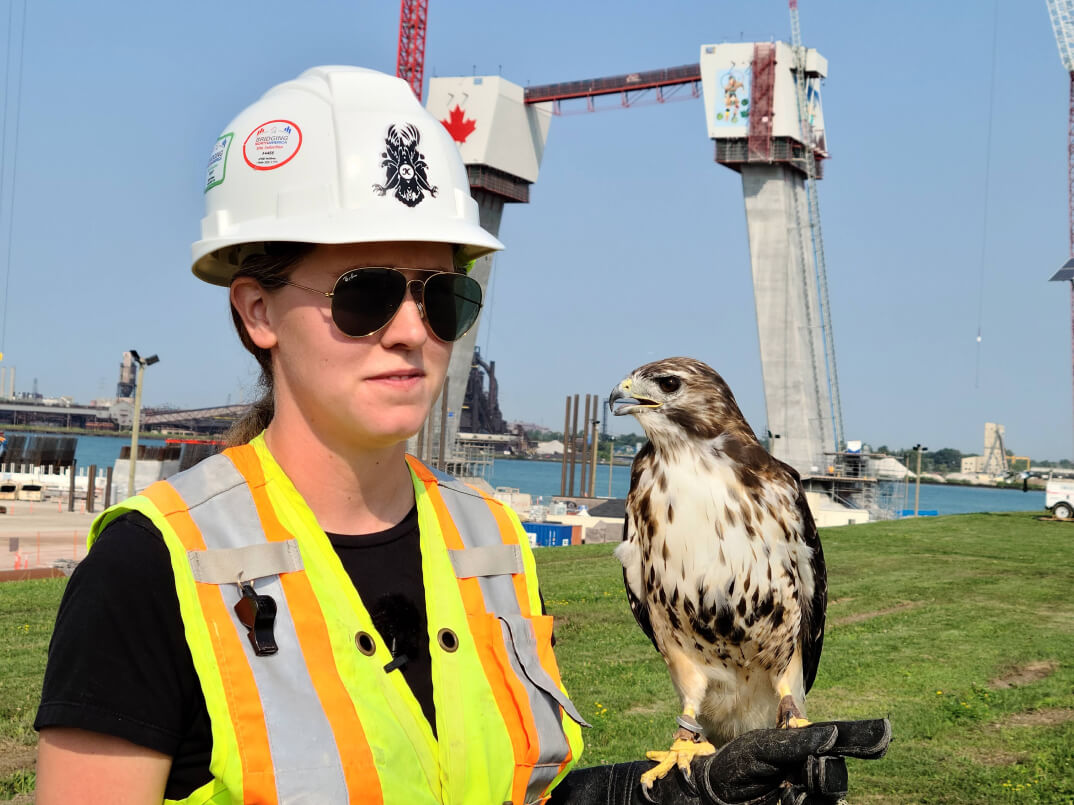
When you think about what you see at a construction site, it’s normal for workers and heavy machinery to be among the first things that comes to mind.
But you may be surprised to learn that falcons, hawks, even owls, are also key elements to construction of the Gordie Howe International Bridge project.
“The falconry program helps deter other birds and wildlife from nesting on the construction site,” says Lindsay Bennett, Environmental Compliance Specialist at Windsor-Detroit Bridge Authority (WDBA).
Bird nesting mitigation measures are included in the environmental management plan for the project developed by WDBA’s private-sector partner, Bridging North America (BNA).
“Not only does the falconry program help protect bird species, including bird species-at-risk from hazards at an active construction site, it also reduces risk of schedule delays which can be costly,” adds Bennett.
For example, if a bird nests at a construction site, the contractor is required by law to create a buffer zone around the nest, where no work is allowed in that area. In some cases, the nest may remain active for several weeks.
Tyler Oglan, BNA’s Environmental Monitor, says the Gordie Howe International Bridge project is attractive to birds because of the surrounding landscapes, proximity to the Detroit River, the massive towers and cranes that are 150metres/500 feet from ground level.
“Falconry is becoming quite common on large construction projects,” notes Oglan. “We have a federal government permit through Environment and Climate Change Canada. It allows us to use the skills of highly trained birds and professionals, beginning in the spring, at a time when birds are looking to nest.”
Kingsport Environmental Falconry Services based in Amherstburg, Ontario, fly birds of prey across the Canadian bridge site and at the Canadian Port of Entry.
Lead Falconer and co-owner Nicole Soucie, says they use four Red-tailed hawks and Harris hawks with two different teams that roam the project site at different locations.
“We have one team that begins walking the site early in the morning, before the sun is up, so the hawks can fly and claim their territory. That way when birds wake up, they can see a threat is present and typically fly away,” says Soucie. “We also have a second team that walks the site until after sunset to ensure other birds looking to sleep for the night go elsewhere.”
The birds of prey are imposing creatures.
Kingsport’s Red-tailed hawks, which are common around Ontario, weigh about two-and-a-half pounds and have a four-foot wingspan. Harris hawks are a little smaller.
“We use different birds of prey because they each have unique looks and flight paths. Red-tailed hawks go up in the air and soar while Harris hawks go from perch to perch,” says Soucie. “We can also bring owls on site to pose a threat to more stubborn birds. By flying different species, it creates a perception that there is a larger threat in the area.”
Soucie says all of their birds are highly trained to return to their handler.
“The birds are trained to learn that handlers are the easiest source of food. While they may see other wildlife, there is no guarantee they can catch it. So as soon as they land on our glove, they get food,” says Soucie. “We can also call them back for food and walk them to another location.”
Kingsport also uses dogs to patrol the property to deter ground nesting birds on the site.
Soucie adds she loves her job and is thrilled to be working on the Gordie Howe International Bridge project.
“The most satisfying part of my job is being able to walk the site every day and see the progress firsthand with my birds,” says Soucie. “I look forward to the day when I can cross the bridge and say that my company was part of a once-in-a-generation project.”



